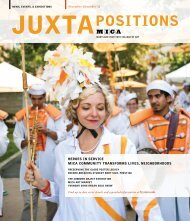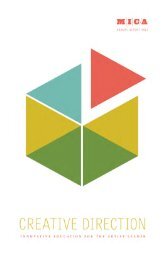art/vision/voice - Maryland Institute College of Art
art/vision/voice - Maryland Institute College of Art
art/vision/voice - Maryland Institute College of Art
Create successful ePaper yourself
Turn your PDF publications into a flip-book with our unique Google optimized e-Paper software.
william stretching his face.<br />
case study: columbia college chicago 41<br />
exercises along with them too, because I wanted to experience<br />
them, to see if I understood the instructions and, you know, be<br />
“down in the pit,” as it were. I think trust was built pretty quickly<br />
that way—we were all in this together.<br />
luis The first day we all worked together, the two student teachers had<br />
to have a lot <strong>of</strong> nerve and energy to be the first ones to get up and<br />
work with the kids. When the Columbia <strong>College</strong> group first came in,<br />
it was pretty hectic. It can get chaotic when you have ten high-school<br />
students, three lead teachers, and then you have ten extra college<br />
students. It becomes a room <strong>of</strong> twenty five people with very different<br />
approaches and directorial <strong>vision</strong>ing. We have so many people<br />
together, it could be potentially disastrous.<br />
ron Almost every time for the first seven or eight weeks, I couldn’t tell<br />
what the Columbia students’ warm-ups were for. I mean, maybe<br />
to get them warm, but obviously a warm-up is more than that. They<br />
have a real purpose. We’d meet back at Columbia <strong>College</strong> on Fridays<br />
and I would say, “Okay, that exercise you did, what was it for?”<br />
And they would look at me and they wouldn’t have a reason for it.<br />
So I’d go, “How do you want your students to be at the end <strong>of</strong><br />
your warm-up?” And then we would develop an idea for an exercise<br />
that would get the students to that place. And then they would<br />
take the exercises they know and match them up with what we<br />
were trying to do.<br />
Beginning teachers sometimes forget all these little steps they<br />
took to understanding, so they leap ahead two or three steps in an<br />
exercise. They try to get to the end without going through the<br />
process. As young teachers, when they get nervous they get tunnel<br />
<strong>vision</strong>, and instead <strong>of</strong> looking at the situation and reacting to it,<br />
they just plow through whatever they’re doing, whether it’s working<br />
or not, trying to get to the end. But the end result flows from the<br />
process—you can’t take those steps away and still have it work.<br />
brian There was a moment about halfway through the course when we<br />
put Luis in a difficult position and then made his position even<br />
more difficult. On this p<strong>art</strong>icular day, one student teacher was<br />
supposed to lead the high school students through a thirty-minute<br />
warm-up and another would do a thirty-minute bridge activity, and<br />
then they’d hand it over to Luis, but what they were doing didn’t<br />
work. They were teaching an improvisation, and they skipped about<br />
five steps. You can’t do that and have it work, so people were<br />
pretending to be doing what was being asked <strong>of</strong> them, but they<br />
weren’t understanding it, and it was pretty painful to watch.
















